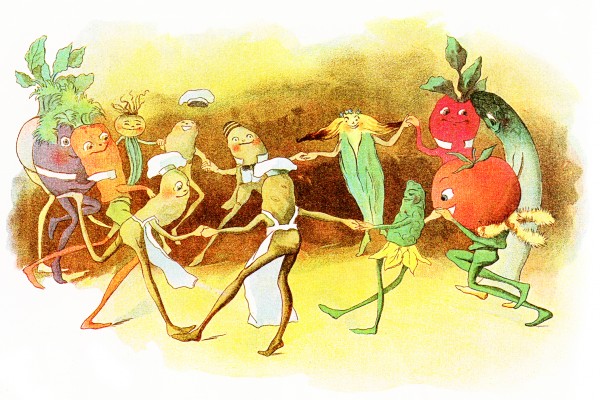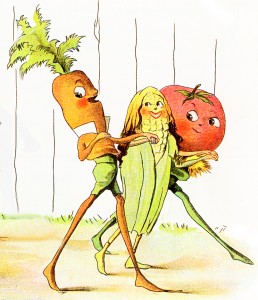Recipes
SWEET CORN
History: Originally wild in Central America, Maize has flourished in the hands and souls of indigenous Americans for the last 8,000 years. From birth thru death, the economic, social, and religious activities of many Native Americans were bound to the growing of maize. Maize was brought to Europe by Columbus, readily accepted, and from there dispersed to all parts of the world, becoming a staple in many countries. Corn now ranks in the top 4 principal food plants worldwide. The word corn means the principal grain of a region and was given to the grain, Maize, by American settlers.
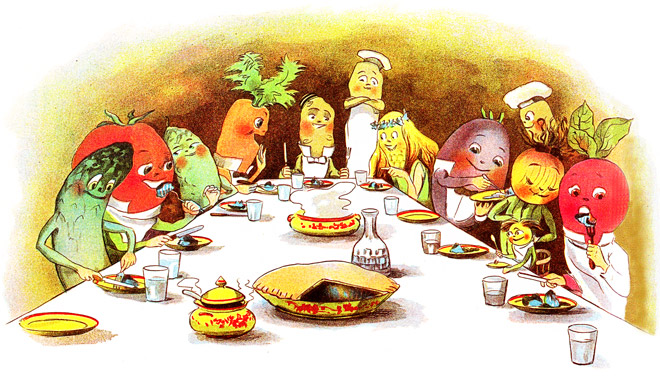
“Maize and people grew up together as children of earth and sky.
You can look it in the eye. Its one on one.”
Season: Mid-July through frost (usually late September).
Nutrition: Corn is a very good source of complex carbohydrates and dietary fiber. It is relatively high in vegetable protein, and like most vegetables it is low in fat and sodium.
| Calories 75 | Protein 4% |
| Protein 3 gm. | Vitamin A 5% |
| Carbo 17 gm. | Vitamin C 10% |
| Fat 1 gm. | Thiamine 9% |
| Sodium 1 mg. | Riboflavin 5% |
| Cholesterol 0 | Niacin 9% |
| Fiber 4 gm. | Calcium * |
| Iron 3% |
Tips:
- A wonderful way to eat sweet corn is uncooked right on the cob. You will enjoy the exquisite taste of the natural sugars, and benefit from all the vitamins and minerals.
- If corn is to be stored in the refrigerator do not remove husks until just before cooking.
- To avoid toughness in cooking sweet corn do not add salt to boiling water.
To Steam Corn on the Cob
Remove husks and silk from fresh corn and place corn upright in large kettle with one inch of boiling water. Cover. Steam until corn is tender. 6-10 min., depending on maturity. Corn should turn from creamy yellow to a brilliant, transparent yellow.
To Boil Corn on the Cob
In a large kettle which you can cover tightly, bring to a rolling boil, enough water to cover corn generously. Slip husked ears into the water one by one. Cover kettle and remove from heat. Allow corn to remain in the hot water for about 5 minutes or until tender. Drain. Serve at once.
Microwave corn on the cob
1 ear 3-4 min. 4 ears 7-10 min.
2 ears 5-6 min. 6 ears 10-12
Leave corn wrapped in husk. Cook on high (100%). Halfway through cooking turn corn over and rearrange. Let stand 2-3 minutes.
For a new seasoning try umiboshi paste.
Grilled or roasted corn
Preheat oven to 400 or have a good bed of coals ready. Pull down husks and remove silk. Pull husk back up. Run into husk as much water as it will hold, or soak the ears in water for 15 min. Put ears on rack over hot coals or in preheated oven. Bake for 20 to 30 min. If cooking over hot coals turn cobs during cooking.
Or: Peel fresh roasting ears. Rub with butter/salt or olive oil/ umiboshi. Wrap in foil. Roast 20 to 30 minutes.
Corn Fritters (serves 4)
Grate: 2 1/2 cups fresh corn
Add: 1 well beaten egg yolk
2 tsp. flour
1/4 tsp. salt
Whip until stiff: 1 egg white
Fold egg white into corn mixture. Saute as pancakes. Do not overcook.
Simple Summer Corn Dishes
For the following recipes remove the kernels from the cob with a sharp knife, then scrape the cob to capture the juices. 1 cob = 1/2 cup.
- Saute sliced green onions, add snow peas and then fresh corn. Cover and cook until tender just the twinkling of an eye. Serve hot.
- Cook cabbage in milk, add fresh corn and parsley. Cook 3 min.
- Be creative Use fresh corn cut off the cob in most any dish you make. Raw in vegetable salads. Add to soups, chili, casseroles, potato salads, corn breads, and 3 bean salads.
Stewed Corn Medley (serves 6)
3 medium onions, sliced thin
2 cloves of garlic, crushed
3 tbsp. olive oil
2 green or red peppers, chopped
3 tomatoes, chopped
2 cups fresh cut corn
Cook onions, and garlic in oil 2-3 min. Add peppers and tomatoes. Simmer, covered, 10 min. Add corn, simmer 5 min. Salt and pepper.
Fresh Corn and Tomato Soup (serves 4)
1/2 onion,chopped
1 stalk celery
1 clove garlic
1 tbsp. oil
4 cups fresh cut corn
4 med. tomatoes, chopped
1/2 tsp. salt
Handful fresh cilantro leaves, chopped
Saute onion, celery, and garlic in a heavy pan until tender. Add corn, tomatoes, 1/2 cup water and salt to sauteed vegetables. Simmer, covered, about 1/2 hour. Puree all the soup. Stir in cilantro just before serving.
Corn Chowder (serves 4-6)
1/2 cup onion, chopped
1/2 cup celery, chopped
1/2 cup potato, diced
1/2 cup parsley, chopped
1 cup fresh cut corn
2 cups milk or soy milk
Simmer 2 cups water, onion, celery, potato, and parsley until half cooked, about 10 min. Add corn. Simmer gently a few minutes, till tender. Add milk. Bring soup to a boil without actually boiling. Salt and pepper to taste.
Frozen Sweet Corn, 5 dozen = 15 pints
1. Peak season, mid August thru Labor Day.
2. Husk corn. Cut bottom end of corn to be flat.
3. Steam in large kettle with 1 inch of boiling water on the bottom for 10 minutes, or until corn becomes bright yellow and transparent. To speed job have several kettles going at once.
4. Immediately put corn into ice water to cool quickly and prevent over cooking. Cool until center cob is cool.
5. Drain corn to remove excess water.
6. Cut corn from the cob. Purchase a corn cutter to make this job easy. Pound a long nail through a piece of wood, and stick the cob onto the nail, then it will cut without slipping.
7. Put into plastic bags and freeze.
Freezing on the Cob, When frozen corn on the cob is cooked it must be completely thawed before cooking or the kernels will be cooked to death by the time the cob is warm.
1. Follow steps 1 thru 5 for freezing corn.
2. Put into bags, seal, and freeze.
Drying Sweet Corn
1. Follow steps 1 thru 6 as for freezing corn.
2. Dry in a food dehydrated, a very low oven, or on screens in the sun. When thoroughly dry, corn should be brittle, semitransparent, and glassy. Store in airtight container.
TO USE: Basic Recipe for Dried Sweet Corn
Combine corn with twice as much water in a saucepan, soak 2 hours. Cover, and simmer 30 min. or until tender. Season to taste. Flavor similar to frozen corn. This can be added to soups, stews, etc.
“People have tried and tried, but sex is not better than sweet corn”. — Garrison Keilor
WINTER SQUASH
History: Squash appears to have originated in Mexico around 8,000 B.C. From there it spread through North and South America. Originally squash had bitter flesh and its food value/use was the seeds. Over time squash was bred with sweeter flesh and became a staple part of many tribes diets. Squash was introduced to the Old World in the late 15th century, and has become popular in many countries. China is now the worlds largest producer.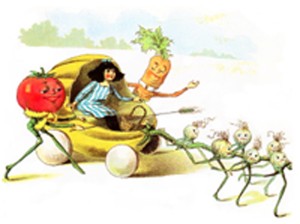
Season: End of August though Halloween.
Selection: When choosing squash, ripeness is of great importance. Immature squash is watery, and lacks in sweetness, nutrition, and flavor. Skins should be firm with well defined color. Squash that looks washed out, usually is.
Nutrition: Winter squash is one of the richest sources of carotene, a precursor of Vitamin A, which gives squash its rich coloring. Recent research suggests that consuming large quantities of carotenoids from natural sources may help to protect against cancer. Squash is also a good source of Vitamin C, fiber, potassium, riboflavin, and minerals.
Winter Squash, baked, 1/2 cup
| Calories 63 | Protein 3% |
| Protein 2 gm. | Vitamin A 84% |
| Carbo 15 gm. | Vitamin C 22% |
| Fat 1 gm. | Thiamine 3% |
| Sodium 1 mg. | Riboflavin 8% |
| Cholesterol 0 | Niacin 4% |
| Fiber 3 gm. | Calcium 3% |
| Iron 4% |
VARIETIES
Acorn: Dark green exterior with bright orange spot on underside. Acorn is an old standard good for stuffing or baking. Good storage.
Butter-cup: Dark green skin with a cup on the bottom. Thick orange flesh, that cooks sweet, with a tender flakiness. An old standby whose rich flavor is yet to be beat. Freezes well.
Butter-nut: Tan colored, bottle shaped, with a small seed cavity. Smooth textured, orange flesh, has nutty flavor. Good storage.
Sweet Dumpling: A delicious, highly ornamental squash. Creamy white rind with green stripes. This is one of the earliest and sweetest of the specialty squash.
Delicata: Nicknamed “Sweet Potato”. Elongated, ivory skin with a green stripe. Individual serving size and sugar sweetness make this a gourmet stuffing and baking squash.
Sugarloaf: Delicata type, with a rusty brown skin tone and a green stripe. Its extra-sweet taste makes this the hottest newcomer of the specialty squashes.
Heart of Gold: Similar to Sweet Dumpling, larger with more of a heart shape. Fine grained, sweet flesh.
Spaghetti: Football shaped, yellow or orange rind. Flesh has spaghetti-like texture, an excellent low-calorie substitute for pasta.
Stripetti: A cross between Delicata and Spaghetti, giving us a unique, new taste sensation.
Honey Delight: Dark green fruits. Bright orange flesh bakes up dry, flaky, and very sweet. Freezes well. Must be mature.
Red Kuri: Bright red, teardrop shaped fruit, with smooth textured flesh. Good for soups and pies as it bakes into a smooth, moist puree.
Hubbard: Old fashioned, all purpose squash, sweet, fine-grained. Freezes and stores exceptionally well.
Baked Winter Squash: Any squash can be cooked this way, in any volume. Wash squash. Cut in half along the equator and remove seeds. Place in baking dish, cut side down, with 1/2 inch of water on bottom of pan. Bake 45 min. to an hour. Shorter baking is moister, firmer. Longer baking is dryer, richer, caramelly. For a dryer, caramelly taste, turn cut side up halfway through baking. Serve in shell,or scoop out and mash. Season.
Steamed Squash: Squash can be steamed instead of baked. Its quicker, and stays very moist. For those preferring dry squash this method is too moist. Cut squash into small pieces. Steam till soft, about 20 to 30 min. Microwaved Squash: Pierce squash skin. Microwave half the cooking time. High (100%). Cut in half. Remove seeds. Cover with wax paper. Cook second half of cooking time. Allow to stand covered 5 minutes. Season.
1 medium squash 8-10 minutes
2 medium squash 20-22 minutes
Experiment with Seasonings: Traditional is butter and salt. Try olive oil, tamari, black pepper, herbs, umiboshi, sauteed red peppers and onions, chili powder or cayenne, garlic, grated ginger, cinnamon and honey, maple syrup.
Mexican Butternut (4-6 servings)
1 butternut squash
1 tbsp. oil
1 tsp. chili powder
1/2 tsp. cumin powder
1 clove garlic, minced
1 tsp. rubbed oregano
Quarter the butternut. Remove seeds. Steam squash 20 minutes. Slice or mash squash, depending on desired texture. Heat oil in heavy pan. Add chili powder, cumin, and garlic. Stir and fry until fragrant. Add squash and oregano, heat to serving temperature. Serve hot.
Gingered Squash (4-6 servings)
3 cups hot, cooked, mashed winter squash.
2 tsp. butter or olive oil
pinch of salt
2 tbsp. finely grated ginger
1 lemon, juiced
2 tbsp. honey
Mix all ingredients. Taste and adjust honey/lemon. Serve hot.
Cranberry Stuffed Squash (4 servings)
2 squash, cut in half, seeds removed.
1/2 cup fresh, raw cranberries, chopped
1 small apple, chopped
1/4 cup raisons, chopped
Juice and grated peel of one orange
2 tbsp. honey
Dash of salt
Place squash in baking dish cut side up. Mix all other ingredients. Place them inside squash cavities. Cover dish and bake until squash is tender, 45 minutes to an hour.
Squash and Tomato Stew (serves 6-8)
1 large onion, chopped
1 green pepper, chopped
2 stalks celery, chopped
1/4 cup olive oil
5-6 cloves of garlic, minced
1 tsp. ground cumin
1/4 cup hot green chili, chopped, adjust to your taste
6 cups chopped tomatoes
1 medium winter squash, cut in 1/2 inch cubes
2 cups fresh cut sweet corn (optional)
1 tsp. salt
1 1/2 cup water
1/4 cup fresh cilantro, chopped
In a large pot saute the onions, pepper, and celery in oil until onions are clear. Add garlic, cumin, and chilies. Saute a few minutes, stirring. Add tomatoes, squash, corn, salt, and water. Cover. Simmer gently for about an hour. Add cilantro just before serving. Serve with rice or hearty bread.
Stuffed Winter Squash (8 servings)
4 squash, halved, seeds removed
1 large onion, chopped
4 cloves garlic, minced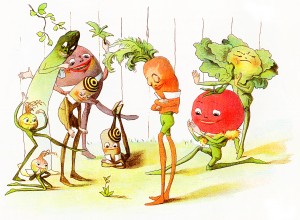
2 stalks celery, diced
8 oz. mushrooms, sliced
1 red pepper, chopped
1/2 cup almonds, sliced (optional)
1/4 cup olive oil
3 cups cooked rice
2 cups fresh cut sweet corn
1 can olives, sliced (optional)
1/2 cup parsley, chopped
2 tbsp. rubbed sage
1 tsp. sea salt
Bake squash cut side down at 375 for 30 minutes. Meanwhile, saute the onion, garlic, celery, mushroom, red pepper, and almonds in olive oil until onions are translucent. Add the rice, corn, olives, herbs, and salt.Take squash out of oven, turn it over and fill with stuffing. Bake for 30 minutes more. Feel free to leave out any vegetable you don’t like or have. Add your favorites.
To Freeze Winter Squash: Bake squash. Scoop out of shell and mash. Cool. Pack into plastic bags and freeze.
Drying Winter Squash: Bake squash just until soft. Cool. Peel. Slice. Dry in low oven, on trays in the sun, or in a food dehydrator. Store in airtight containers.
To Use: Eat dry, like fruit leather, or soak in water 1 hour, then cook in soak water to a puree, season. Add to soups, stews etc.
Storing Winter Squash: Winter squash can be stored until the new year. Choose squash that is well formed, mature, and unbruised with a good firm rind. To lengthen storage time, squash can be “cured” by placing in a warm sunny spot (75-85) for 7-10 days. This causes the squash to sweat a natural sealing wax which coats and further protects the squash. Store in a cool (45-55), dry, well ventilated place. Store with squash not touching each other. Does not store well when the growing season ends with a very wet fall. The longest storing varieties are Acorn, Hubbard, Butternut, and Spaghetti.
POTATOES
History: The potato as we know it today, is the result of thousands of years of selection and cross breeding of wild potato species. It appears to have first been cultivated 4,000 to 7,000 years ago in the Andes mountains between Bolivia and Peru. From there it spread through South America and became a wide spread food crop, especially valuable in mountainous areas where little else would grow. The first potatoes came to Europe in the 1500’s. They were greeted with little enthusiasm, being considered poisonous and the cause of leprosy, until they reached Ireland where they quickly became a staple of for the poor. The Irish economy became so dependent on the potato that failure of the potato crop in 1845 brought about severe famine and emigration from Ireland. Potatoes did not become an important part of the English diet until the 18th century. Today potatoes rank in the top 4 principal foods worldwide.
Nutrition: In just 400 years, the potato has replaced grain as a basic source of nutrition in many nations around the world, Why? Because the potato is one of the best bundles of nutrition known to mankind. Its carbohydrate – to – protein ratio is ideal, and it provides significant amounts of Vitamin C, potassium, thiamine, and niacin. Since we don’t spray our crops with chemicals you can be comfortable serving them in nutrient rich skins.
The potato yields more nutritious food, more quickly,on less land and in harsher climates than any other major food crop!
- Red Potatoes are firmer, hold their shape well. and take longer to cook. Use for soups, salads, steamed or boiled.
- Yellow Potatoes have a yellow fleshed interior, with a buttery, creamy taste. They cook quickly. Recommended for hash browns, pancakes, pureed soups, mashed, fried, baked, or boiled.
- Purple or Blue Potatoes have a lavender interior which holds its color in cooking. Best for baking, dry and flaky.
- Russet Potatoes are best used for baking. Dry and flaky.
The Greening of the Potato: If potatoes are exposed to light for too long the skin turns green. When this happens the toxin solanine is present. causing the potato to be bitter and toxic. Peeling deeply will remove most of the poison, but if more than half the skin is green it is best to throw the potato away.
Baked Potatoes: Preheat oven to 400°. Prick scrubbed potatoes with a fork. Bake one hour or until soft.
Microwave Baked Potatoes: 1 potato 4-6 min. 2 potatoes 6-8 min. 4 potatoes 12-14 min. 6 potatoes 16-18 min. Prick scrubbed potatoes. Place on layer of paper towel. Leave 1/2 inch between potatoes. Cook high (100%). Halfway through cooking turn potatoes over and rearrange.
Boiled Potatoes: Quarter scrubbed potatoes and place in saucepan with water to cover. Boil until tender, about 20-30 min. Drain. Seasonings: Traditional seasoning, butter, salt and black pepper. Experiment with chopped herbs, olive oil, soy sauce, umiboshi, cayenne, baked garlic, sauteed red pepper and onion, cheese.
Steamed New Potatoes: (4-6 servings) 2 lbs. small new potatoes of even sizes 3 tbsp. olive oil or melted butter Fine chopped parsley and-or basil, dill, oregano. Wash potatoes with skins intact. Place whole in vegetable steamer and steam until tender, about 20 minutes. Put hot potatoes in a serving bowl and toss with olive oil and butter. Sprinkle with herbs, salt and pepper.
Potato Pancakes (makes 12 cakes) 2 cups grated potato 3 eggs, beaten 2 tbsp. flour 1/2 tsp. salt 3 tbsp. onion Place grated potato into a cloth and extracts as much moisture as possible. Put potatoes in bowl. Add eggs and onions. Mix. combine flour and salt. Mix into potato mixture. Shape into 1/4 inch thick patties. Cook as pancakes. Serve with applesauce.
Oven Fries (serves 4) 3 large potatoes 1 tbsp. olive oil 1/4 tsp. salt Preheat oven to 400 degrees. Cut potatoes into french fry shape. Place in bowl and toss with oil and salt. Spread on greased cookie sheet, one layer deep. Bake about 35 min.
Campfire / Grill Potato Packets follow the Oven Fries recipe till mixed in bowl. Wrap potatoes in aluminum foil, and place over coals. Bake 20-30 min. depending on heat of coals. turn halfway through baking.
What has eyes but can not see?Potato-Leek Soup (serves 4)
2 tbsp. olive oil 1 large leek
1/2 tsp. salt 4 potatoes, diced
1 carrot, chopped 1 stalk celery, chopped
3 sprigs parsley, chopped fine.
Saute leek in oil with salt. Add carrot and celery. Saute a few minutes. Add 2 cups water and potatoes. Simmer until potato is soft. Add pepper and parsley. Can be pureed.
Hash Brown Potato (4 servings) Combine with a fork: 3 cups finely grated raw potatoes 3 tbsp. grated onion 1 tbsp. chopped parsley 1/2 tsp. salt & 1/4 tsp. black pepper Heat 3 tbsp. oil in large skillet. Spread potato moisture thinly in skillet. Press into a cake. saute slowly. When bottom is well browned, flip and slowly brown other side. Serve hot.
Colcannon, Irish Potatoes
4 medium potatoes 3-12 cups chopped kale 3 leeks or 1 large onion 1 tbsp. olive oil 1/3 cup milk or soy milk 1/4 cup chopped parsley
Quarter potatoes and steam. Put kale on to steam separately. Meanwhile chop leeks or onions and saute in oil, stirring frequently. When potatoes are tender, drain, then mash. When kale is tender, drain it well. Combine potato, kale, milk, parsley, leek, and salt & pepper to taste. Serve hot.
Potatoes Tarragon (serves 4) 1 large onion 1 tbsp. olive oil 3 large potatoes 1 bay leaf 3 tbsp. vinegar 1 tsp. dried tarragon or 1 tbsp. fresh 1/2 tsp salt & 1/4 tsp. black pepper
Slice onion into long strips. Saute in oil until transparent, Slice potatoes in half lengthwise, then in semi-circles 1/4 inch think, Add potatoes to onions along with bay leaf, vinegar, tarragon, sale and pepper, Add just enough water to cover potatoes. Cover. Simmer for 30-45 min., until potatoes begin to crumble. Stir gently from time to time. Remove bay leaf. Serve hot.
TOMATOES
Freezing Tomatoes
Tomatoes are easily frozen in many forms. They must be used in cooked food after freezing.
Simply core and quarter, throw into a freezing bag and freeze.Use as is in soups and stews.
Tomato sauce can be frozen as is.
Dried Tomatoes
Ideally use a food dryer, as tomatoes are so moist, sun drying can be a challenge in Minnesota.
Slice fresh, ripe tomatoes 1/2 inch thick. Dry in dryer. Store in airtight container.
To use:
Eat as is for a chewy snack.
Throw into soups and stews.
Marinate tomatoes in water, olive oil, oregano, and marjoram, one hour. Great on Greek salad, or as side dish. Puree for tomato sauce.